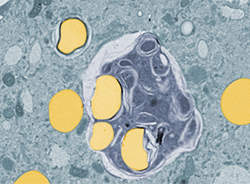Animais em pesquisas
O Brasil finalmente vai ganhar um laboratório destinado a evitar o sacrifício de animais nas pesquisas científicas.
Os animais foram importantes durante uma longa fase da ciência e da medicina, mas hoje já existem várias técnicas que evitam o sacrifício a cada teste de uma molécula ou de um candidato a medicamento.
Se o estágio atual da tecnologia não permite ainda eliminar totalmente os testes com animais, isto se deve em grande parte à falta de interesse de muitos cientistas em encontrar alternativas, uma vez que sacrificar um animal é muito mais simples e rápido.
Alternativa ética
É claro que vários grupos de pesquisadores já se dedicam ao tema, sendo eles os grandes responsáveis pelo desenvolvimento das novas técnicas já disponíveis.
Mas esses cientistas mais éticos nunca tiveram seus esforços totalmente recompensados pela falta de apoio para que os testes alternativos fossem validados e aceitos.
O novo Centro Brasileiro de Validação de Métodos Alternativos (Bracvam) é o primeiro esforço coordenado feito no Brasil com essa finalidade.
O Bracvam vai se dedicar inteiramente ao desenvolvimento de métodos alternativos para a validação de pesquisas que não utilizem animais na fase de testes.
O Centro será instalado pela Fundação Oswaldo Cruz (Fiocruz), através do Instituto Nacional de Controle de Qualidade em Saúde (INCQS), com a colaboração da Agência Nacional de Vigilância Sanitária (Anvisa).
"De maneira organizada, vamos trabalhar os dados e organizar grupos de pesquisas para que novas metodologias sejam fomentadas e passem a ser métodos oficiais," afirmou Isabela Delgado, pesquisadora do INCQS.
Ciência sem sacrifício de animais
Vários países já proíbem não apenas o sacrifício dos animais, mas também a produção e a importação de produtos desenvolvidos com testes em cobaias.
Ao lado da questão ética do sofrimento das cobaias, as pesquisas que utilizam animais são vistas como menos refinadas do ponto de vista técnico científico.
Já se sabe, por exemplo, que os experimentos com animais não levam em conta aspectos caracteristicamente humanos das doenças, como os componentes cognitivos e emocionais envolvidos.
Há poucos dias, uma equipe demonstrou que os camundongos utilizados nas pesquisas sobre doenças do coração não representam um modelo adequado para as doenças cardíacas humanas - o que funciona no coração do camundongo não funciona no coração humano.
Ao lado disso, já há uma grande preocupação dentro da própria comunidade científica sobre a possibilidade da criação de quimeras, criaturas híbridas humano-animais.
"Buscamos mais avanço técnico, resultados mais confiáveis, menos susceptíveis a erros, de menor custo e de mais fácil difusão em outros países," disse Isabella. "Encontramos 14 pesquisas de métodos alternativos no país e nossa ideia é reunirmos essa capacitação, pesquisarmos juntos."
Validação de métodos alternativos
Segundo Eduardo Leal, também do INCQS, universidades públicas brasileiras e centros de produção de vacinas, como o Instituto Butantan e o Adolph Lutz, têm estudos para validação de métodos alternativos.
Mas, segundo ele, a participação da Anvisa é crucial para que essas novas metodologias sejam validadas e aceitas na regulamentação dos produtos.
A União Europeia proíbe desde 2004 a utilização de cobaias em linhas de desenvolvimento de artigos direcionados ao mercado da beleza.
Preocupados com essa tendência, algumas indústrias no Brasil também têm investido para abolir teste com animais na produção de cosméticos.
Alternativas ao uso de animais em pesquisas
Veja alguns resultados recentes divulgados pelo Diário da Saúde que evitam o sacrifício de animais nas pesquisas científicas:
- Cientista cria alternativa para o uso de animais no teste de medicamentos
- Fígado artificial vai substituir testes de medicamentos em animais
- Genoma do camundongo mostra deficiências de seu uso como modelo animal
- Boneca feita com células vivas poderá substituir modelos animais
- Pesquisa com animais não é mais necessária na era do genoma, diz associação
- O passado e o futuro das experiências com animais
- Europa restringe o uso de animais em pesquisas científicas
- Animais nas pesquisas científicas: até quando?




